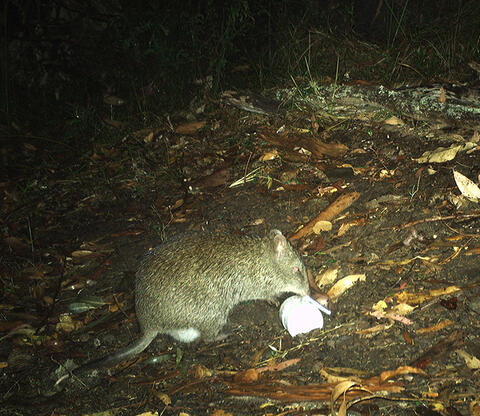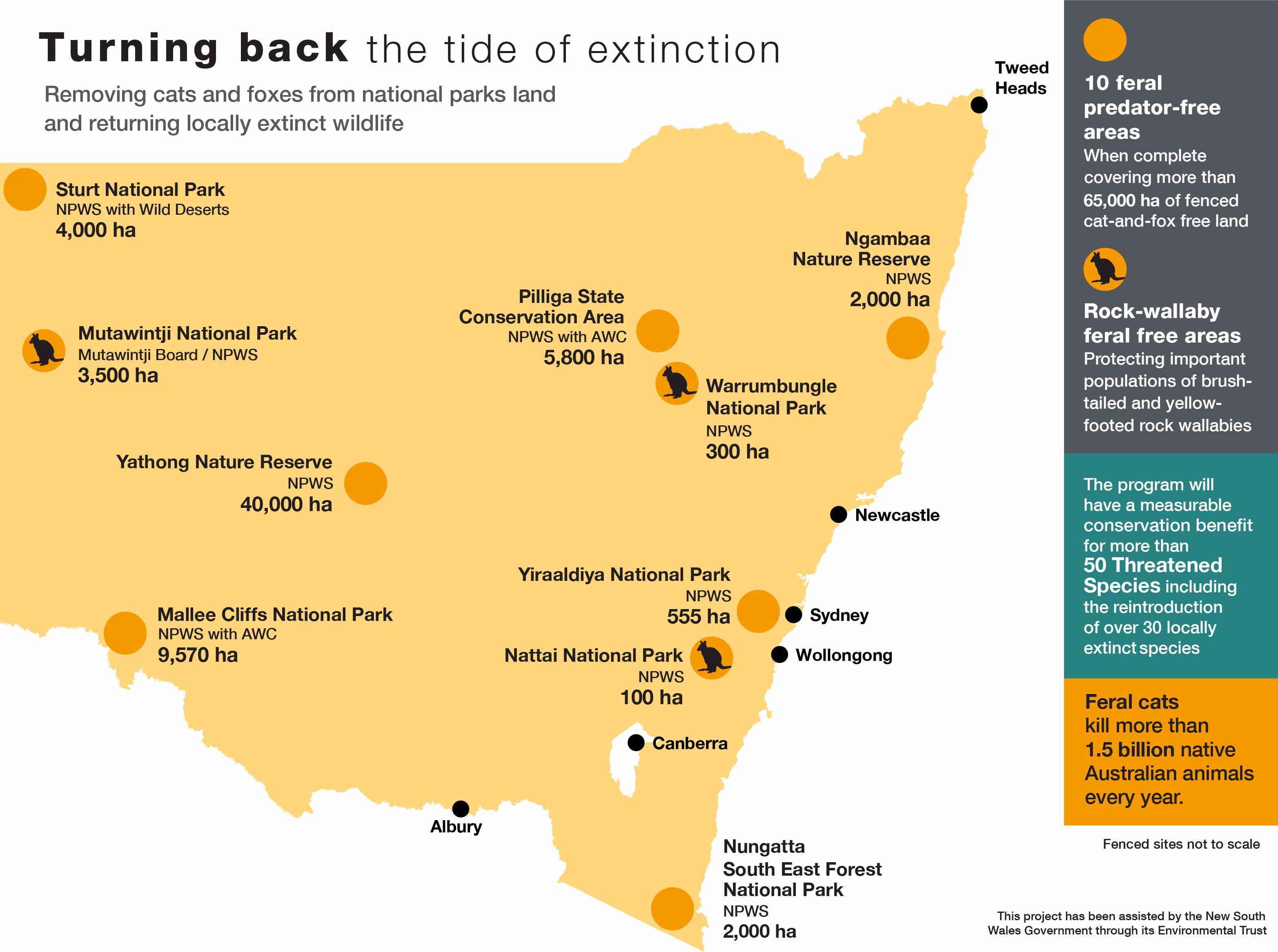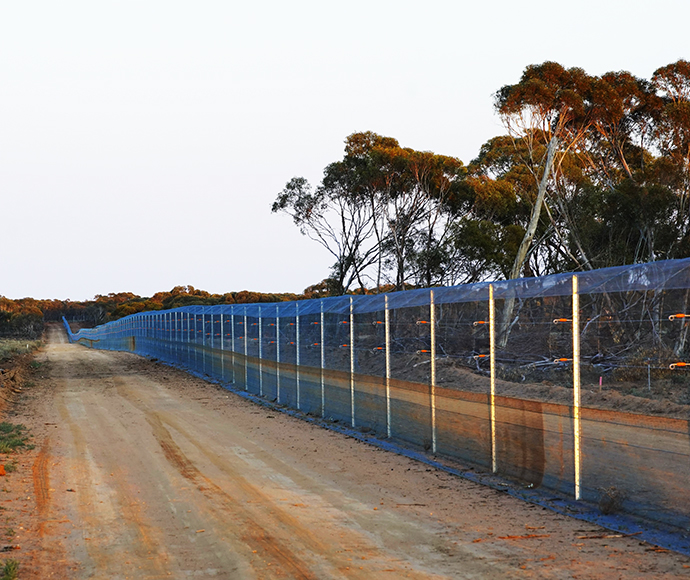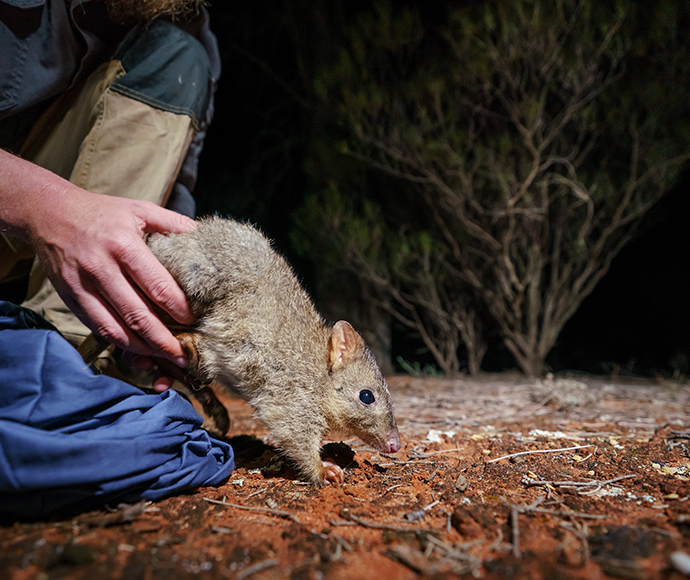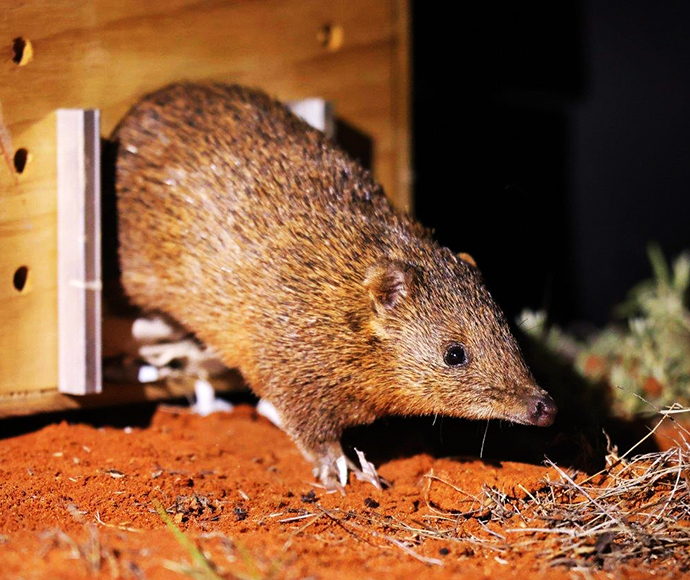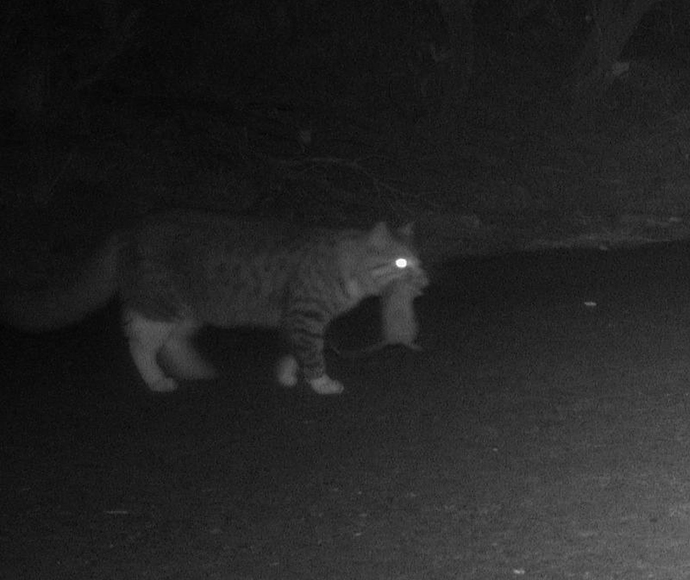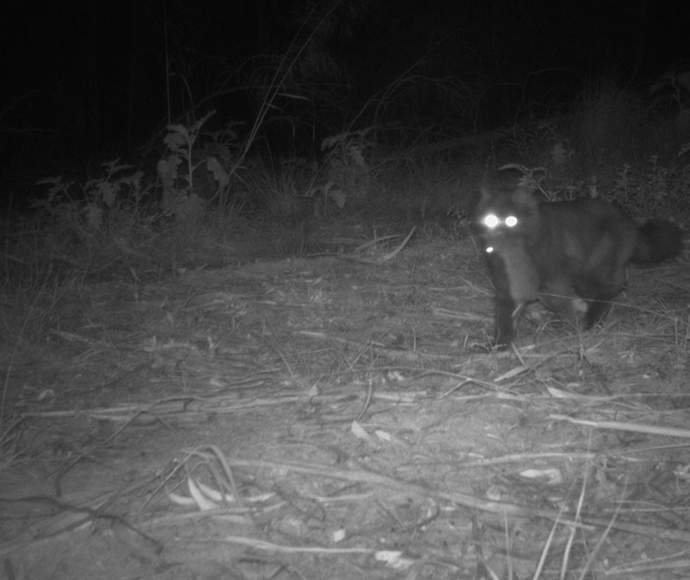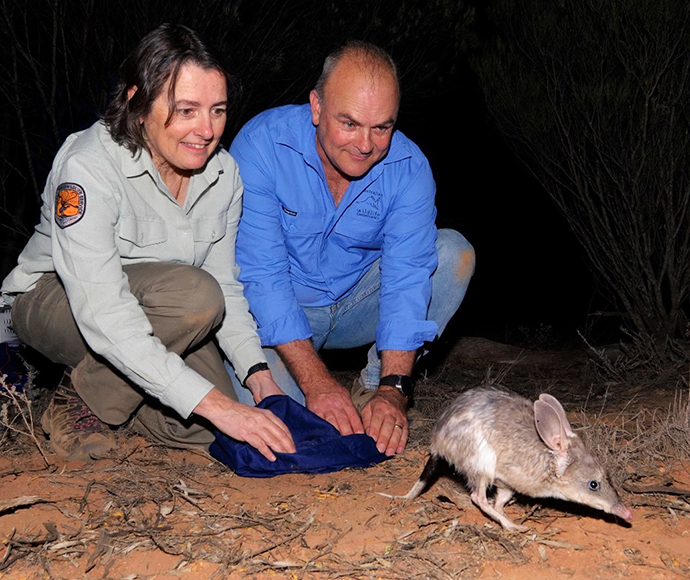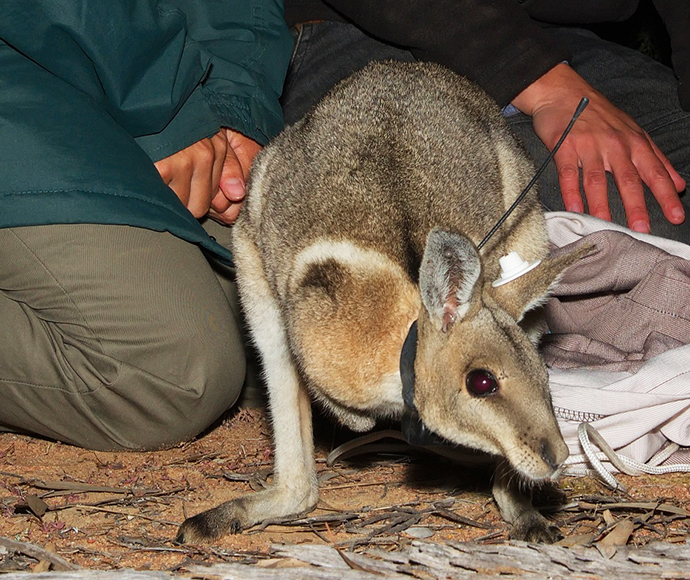A network of feral predator-free areas is one of several strategies in the NSW National Parks and Wildlife Service Threatened Species Framework to meet our commitment of zero extinctions and restore threatened species populations. Other strategies include:
- declaring Assets of Intergenerational Significance
- adding key threatened species habitat to national park estate
- undertaking the largest feral animal control program in national park history
- considering threatened species in new fire plans
- rolling out a world-class ecological health framework across national parks.
World-leading feral predator-free network
The NSW Government is establishing a network of 10 feral predator-free areas across the state as part of a science-driven rewilding initiative.
Rewilding – the process of restoring natural ecological processes in the landscape – has already begun on 3 sites on national park estate. Thirteen species have been reintroduced that were previously extinct in New South Wales.
The project delivers exceptional ecological outcomes, positioning New South Wales as a world-leader in rewilding, restoration ecology and feral predator control.
Once all 10 sites are complete, almost 65,000 hectares of national park estate will be free of feral predators.
The network will provide a significant conservation benefit for more than 50 species – some of which have not been seen in the wild in New South Wales for over a century.
Cats, foxes and other feral animals will be removed from specially fenced areas, then native animals which are extinct in New South Wales, locally extinct or threatened will be brought back into these safe havens. Resident threatened species will also benefit.
The feral predator-free area project is one of the most significant ecological restoration projects in the state's history.
The 10 conservation areas
Our 10 feral predator-free areas are spread across NSW national parks estate, representing a range of different habitats.
Three sites are managed in partnership between the National Parks and Wildlife Service and either the Australian Wildlife Conservancy (AWC) or the University of New South Wales (UNSW Sydney), operating as Wild Deserts.
The National Parks and Wildlife Service is establishing another 4 multi-species sites. Sites were selected to protect the maximum number of priority species while taking into consideration a range of environmental, cultural, operational and economic factors. Future visitor access and opportunities to raise public awareness were also considered.
Three sites will protect important populations of brush-tailed rock-wallabies and yellow-footed rock-wallabies.
Three areas managed by partnerships
Three feral predator-free areas are managed through partnerships between the National Parks and Wildlife Service, University of New South Wales (operating as Wild Deserts) and Australian Wildlife Conservancy (AWC). These 3 partnership sites are:
- Pilliga State Conservation Area, near Baradine, north-west New South Wales – fenced area 5,800 hectares (National Parks and Wildlife Service in partnership with Australian Wildlife Conservancy)
- Sturt National Park, near Tibooburra, far north-west New South Wales – fenced area 4,000 hectares (National Parks and Wildlife Service in partnership with Wild Deserts)
- Mallee Cliffs National Park, near Buronga, south-west New South Wales – fenced area 9,570 hectares (National Parks and Wildlife Service in partnership with Australian Wildlife Conservancy).
Seven new areas run by National Parks and Wildlife Service
The National Parks and Wildlife Service is currently developing 7 new, carefully chosen feral predator-free areas covering diverse habitat types and protecting species with high susceptibility to predation. This maximises the number of species protected.
Three new eastern sites are a first for New South Wales, extending vital feral predator-free areas to critically endangered and threatened species not found inland. One of these will be the first wet forest feral predator-free area in south-eastern Australia.
Another site will pioneer a new scale of intervention for inland species, becoming one of the largest feral predator-free area on mainland Australia: Yathong Nature Reserve. It will be 4 times the size of Mallee Cliffs, the next-largest feral predator-free area in New South Wales.
The 7 sites are:
- Yiraaldiya National Park (formerly Shanes Park), Western Sydney – fenced area 555 hectares
- Yathong Nature Reserve, near Cobar, central New South Wales – fenced area 40,000 hectares
- Ngambaa Nature Reserve, near Macksville, north-east New South Wales – fenced area 3,000 hectares
- Nungatta in South East Forest National Park – fenced area 2,000 hectares
- Mount Uringery in Warrumbungle National Park – fenced area 300 hectares for brush-tailed rock-wallaby
- Mutawintji National Park – goat exclusion fenced area 3,500 hectares for yellow-footed rock-wallaby
- Nattai National Park – fenced area 100 hectares for brush-tailed rock-wallaby.
Why do we need these areas?
'Australia's extinction record is poor and we continue to experience global extinctions of endemic species.'
(Woinarski et al. 2017b)
Australia has the worst mammal extinction record in the world.
More than 10% of our native land mammal species are extinct. Our biodiversity continues to decline, and the number of species at risk of extinction continues to rise.
The primary driver of mammal extinction and decline is predation by feral cats and foxes. Feral cats are implicated in the extinction and decline of many Australian mammals and some bird, reptile and amphibian species.
Each year across Australia, feral cats alone are estimated to kill more than 1.5 billion native animals.
The decline of our wildlife is occurring even in our protected areas. Some species are locally extinct across the national park estate, while others now occur in much lower numbers and are at risk of local extinction.
In 2020, an Australian Government Parliamentary Inquiry into the problem of feral and domestic cats in Australia recommended that governments work to expand the network of feral predator-free areas across a range of ecosystems and be ambitious in their scale.
Compelling evidence
The call to expand feral predator-free networks is backed by compelling evidence for the importance of 'safe havens' across Australia.
- Reintroductions have increased the number of secure populations, and global population size, of threatened mammals (Woinarski et al. 2014).
- Reintroductions have restored regionally extinct mammals to parts of their former range, helping maintain the long-term adaptive potential of the threatened mammals (Weeks et al. 2015).
- Reintroductions play a crucial role in the restoration of Australian ecosystems. Small-medium sized mammals participate in several important ecological processes, including herbivory, seed and spore dispersal, soil engineering and predation (Garkaklis et al. 1998; Murphy et al. 2005; James and Eldridge 2007; Eldridge and James 2009; James et al. 2009; Fleming et al. 2014; Hayward et al. 2016).
Bringing back 'ecosystem engineers'
One of the many locally extinct species coming back is the greater bilby – an 'ecosystem engineer'.
They have earnt their nickname through actions in the landscape. Greater bilbies dig burrows, aerate the soil, and create niches for moisture, spores and seed, or shelter for other species. All of this combines to help return the bush to what it was before.
A total of 13 species listed as extinct in New South Wales, together with other threatened species such as plains mouse, smoky mouse, New Holland mouse and koala, have been reintroduced to feral predator-free areas:
- eastern bettong
- greater bilby
- bridled nail-tail wallaby
- crest-tailed mulgara
- brush-tailed bettong
- Mitchell's hopping mouse
- greater stick-nest rat
- numbat
- Shark Bay bandicoot
- red-tailed phascogale
- golden bandicoot
- burrowing bettong
- western quoll.
Measurement and results
'They [safe havens] have prevented 13 mammal species from going extinct and have protected populations of 40 mammal species susceptible to cats and foxes.'
(Legge et al. 2019)
It's all about science and results, and there will be measurable project conservation benefits for at least 50 threatened animal species, including:
- re-establishing species listed as extinct in New South Wales, such as the iconic greater bilby, western quoll and eastern bettong
- establishing new populations of locally extinct species – such as the critically endangered long-footed potoroo, the eastern quoll and the bushfire-affected smoky mouse
- reducing the extinction risk for existing threatened species, including bushfire-affected red-legged pademelon, the iconic koala and malleefowl.
The 3 feral predator-free areas already established in New South Wales are showing early encouraging signs of bounce-back of resident species, including small mammal and reptile assemblages, as well as abundance and occupancy of ground-dwelling birds.
Reintroduced mammals such as the greater bilby, golden bandicoot, brush-tailed bettong and Shark Bay bandicoot population have more than tripled in number.
Feral predators: cats and foxes
'Over 30 mammal species (>13% of all terrestrial Australian mammals, and all endemic) have been driven to extinction in the past 250 years. Cats and European red foxes (Vulpes vulpes) have been the main drivers for at least two-thirds of these losses.'
(Short and Smith 1994; Woinarski et al. 2015)
Feral cats and foxes are the key drivers of the decline of most mammals, and have a serious impact on bird, reptile and amphibian species.
Despite efforts, there is no effective strategy for landscape-scale control of feral cats, while landscape-scale fox control has mixed results and requires sustained effort.
The effective control of feral predators is essential for the recovery of many of our threatened species, especially mammals and ground-dwelling birds.
Feral cats are listed as a key threatening process under the NSW Biodiversity Conservation Act 2016 and the Commonwealth's Environment Protection and Biodiversity Conservation Act 1999.
Feral goats, rabbits, deer and pigs damage habitat and compete for resources.
The impact of feral predation is compounded in areas where vegetative cover has been removed during drought or by feral animal grazing pressure, or in areas recovering from the impacts of bushfire.
Science says: protect native species
'A network of islands and exclosures that are free of introduced predators is a necessary complement to the conventional reserve system and is required in the short to medium-term to prevent extinction of predator-susceptible threatened mammal species.'
(National Environmental Science Program (NESP) Threatened Species Recovery Hub, 2018).
Until there is effective landscape-scale control of feral cats and foxes, the best available science says we need to establish more feral predator-free areas.
There is strong scientific support for establishing feral predator-free areas using conservation fencing as an essential component of any overall strategy to prevent further extinctions and promote the recovery of our most susceptible species.
The 2019 Threatened Species Mammal Index shows:
- an average increase of 500% for 15 threatened mammals between 2000 and 2016 due to conservation in feral predator-free areas
- an average 60% decrease between 1995 and 2016 for 32 mammals in sites with no targeted management intervention.
The feral predator-free areas will establish insurance populations of threatened species in the short and medium term until effective landscape control of feral cats and foxes is developed.
